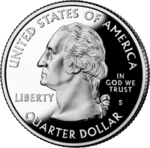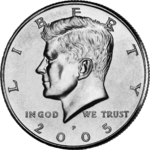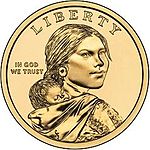- Coins of the United States dollar
-
United States coinage was first minted by the new republic in 1792. New coins have been produced every year since then and they make up a valuable aspect of the United States currency system. Today circulating coins exist in denominations: $0.01, $0.05, $0.10, $0.25, $0.50, and $1.00. Also minted are bullion (including gold, silver and platinum) and commemorative coins. All of these are produced by the United States Mint. The coins are then sold to Federal Reserve Banks which in turn are responsible for putting coins into circulation and withdrawing them as demanded by the country's economy.
Contents
Current coinage
Today four mints operate in the United States producing billions of coins each year. The main mint is the Philadelphia Mint[1], which produces circulating coinage, mint sets and some commemorative coins. The Denver Mint[2] also produces circulating coinage, mint sets and commemoratives. The San Francisco Mint[3] produces regular and silver proof coinage, and produced circulating coinage until the 1970s. The West Point Mint[4] produces bullion coinage (including proofs). Philadelphia and Denver produce the dies used at all of the mints. The proof and mint sets are manufactured each year and contain examples of all of the year's circulating coins.
The producing mint of each coin may be easily identified, as most coins bear a mint mark. The identifying letter of the mint can be found on the front side of most coins, and is often placed near the year. Unmarked coins are issued by the Philadelphia mint. Among marked coins, Philadelphia coins bear a letter P, Denver coins bear a letter D, San Francisco coins bear a letter S, New Orleans coins bear a letter O and West Point coins bear a letter W. S and W coins are rarely, if ever, found in general circulation, although S coins bearing dates prior to the mid-1970s are in circulation. CC and D mint marks were used for a short time in the early-to-mid-nineteenth century by temporary mints in Carson City, Nevada and Dahlonega, Georgia, respectively; all such coins are now in the hands of collectors and museums.
Coins in circulation
Value Image Specifications[5] Description Minted Usage Common Reference Obverse Reverse Diameter Thickness Mass Composition Edge Obverse Reverse $0.01 

19.00 mm 1.55 mm 1909-1982
3.11 gcopper 95%
tin/zinc 5%1Plain Abraham Lincoln Wheat 1909–1958 wide2 Wheat Penny, Penny, Cent 
19.05 mm Lincoln Memorial 1959–2008 wide see article: 2009 Redesign 1982-
present
2.50 gcore:
zinc 97.5% plating:
copper 2.5%1Lincoln bicentennial series 2009 
Union shield 2010–present $0.05 

21.21 mm 1.95 mm 5.00 g copper 75%
nickel 25%3Plain Thomas Jefferson Monticello 1938–1942, 1946–2003 wide Nickel see article: Westward Journey nickel Westward Journey Series 2004–2005 

Monticello 2006–present $0.10 

17.91 mm 1.35 mm 2.268 g copper 91.67%
nickel 8.33%4118 reeds Franklin D. Roosevelt Torch, oak branch, olive branch 1965–present wide Dime $0.25 
24.26 mm 1.75 mm 5.67 g 119 reeds George Washington Bald Eagle 1965–1974, 1977–19985 wide Quarter 
Bicentennial colonial military drummer (1975) 19765 
See article: 50 State Quarters State Quarter Series 1999–2008 See article: D.C. and U.S. Territories Quarters D.C. and U. S. Territories Quarters 2009 See article: America the Beautiful Quarters America the Beautiful Quarters 2010–2021 $0.50
(rare)

30.61 mm 2.15 mm 11.34 g 150 reeds John F. Kennedy Seal of the President of the United States surrounded by 50 stars 1971–1974, 1977–present5 limited6 Half dollar, 50-cent piece 
Independence Hall (1975) 19765 $1
(rare)

26.50 mm 2.00 mm 8.10 g reeded Susan B. Anthony Apollo 11 mission insignia 1979–1981, 19998 limited6 SBA, Suzie B. 

26.50 mm 2.00 mm 8.10 g copper 77%
zinc 12%
manganese 7%
nickel 4%plain Sacagawea Bald Eagle in flight 2000–2008 Gold(en) dollar, Sacajawea see article: Native American $1 Coin Act Plain w/ incused inscriptions Native American Themes 2009–present see article: Presidential $1 Coin Program7 
Each deceased president Statue of Liberty 2007–present Gold(en) dollar These images are to scale at 2.5 pixels per millimeter. For table standards, see the coin specification table. Remarks
- The mass and composition of the cent changed to the current copper plated zinc core in 1982. Both types were minted in 1982 with no distinguishing mark. Cents minted in 1943 were struck on planchets punched from zinc coated steel which left the resulting edges uncoated. This caused many of these coins to rust. These "steel pennies" are not likely to be found in circulation today, as they were later intentionally removed from circulation for destruction.
- The wheat ear cent was mainstream during its time. Some dates are rare, but some can still be found in circulation.
- Nickels produced from mid-1942 through 1945 were manufactured from 56% copper, 35% silver and 9% manganese. This allowed the saved nickel metal to be shifted to industrial production of military supplies during World War II.
- Prior to 1965 and passage of the Coinage Act of 1965 the composition of the dime, quarter, half-dollar and dollar coins was 90% silver and 10% copper. The half-dollar continued to be minted in a 40% silver-clad composition between 1965 and 1970. Dimes and quarters from before 1965 and half-dollars from before 1971 are generally not in circulation due to being removed for their silver content.
- In 1975 and 1976 bicentennial coinage was minted. Regardless of date of coining, each coin bears the dual date "1776-1976". The Quarter-Dollar, Half-Dollar and Dollar coins were issued in the copper 91.67% nickel 8.33% composition for general circulation and the Government issued 6-coin Proof Set. A special 3-coin set of 40% silver coins were also issued by the U.S. Mint in both Uncirculated and Proof.
- Use of the Kennedy half-dollar, Susan B. Anthony and Sacagawea dollars is not as widespread as that of other coins in general circulation; most Americans use quarters, dimes, nickels and pennies only. Coins are minted for general release through banks and other financial institutions, and are also available for collectors in uncirculated rolls, mint sets and proof sets from the United States Mint.
- The Presidential Dollar series features portraits of all deceased U.S. Presidents with four coin designs issued each year in the order of the president's inauguration date. These coins began circulating on February 15, 2007.
- The Susan B. Anthony dollar coin was minted from 1979–1981 and 1999. The 1999 minting was in response to Treasury supplies of the dollar becoming depleted and the inability to accelerate the minting of the Sacagawea dollars by a year. 1981 Anthony dollars can sometimes be found in circulation from proof sets that were broken open, but these dollars were not minted with the intent that they circulate.
Bullion coins
Non-circulating bullion coins have been produced each year since 1986. They can be found in silver, gold and also platinum since 1997. The face value of these coins is legal as tender, but does not actually reflect the value of the precious metal contained therein. On 11 May 2011, Utah became the first state to accept these coins as the value of the precious metal in common transactions. The Utah State Treasurer assigns a numerical precious metal value to these coins each week based on the spot metal prices.
Type Diameter Fineness Face Value Content American Silver Eagle 40.6 mm 999 fine silver $1 1.00 troy ounce (~31.10 grams) American Gold Eagle 16.5 mm
22.0 mm
27.0 mm
32.7 mm916 fine gold (22 karat) $5
$10
$25
$500.10 ozt (~3.11 g)
0.25 ozt (~7.78 g)
0.50 ozt (~15.6 g)
1.00 ozt (~31.10 g)American Platinum Eagle 16.5 mm
22.0 mm
27.0 mm
32.7 mm999.5 fine platinum $10
$25
$50
$1000.10 ozt (~3.11 g)
0.25 ozt (~7.78 g)
0.50 ozt (~15.56 g)
1.00 ozt (~31.10 g)American Buffalo 32.7 mm 999.9 fine gold (24 karat) $50 1.00 ozt (~31.10 g) America the Beautiful Silver Bullion Coins 76.2 mm 999 fine silver 25¢ 5.00 ozt (~155.5 g) Commemorative coins
Modern commemoratives have been minted since 1982. An incomplete list is available here.
Composition of US Modern Commemorative Coins Type Total Weight Diameter Composition Precious Metal Content Half Dollar 11.34 g 30.61 mm (1.205 in) Cu 92%, Ni 8% none Dollar 26.73 g 38.1 mm (1.500 in) Ag 90%, Cu 10% silver 24.057 g (~0.773 ozt) Half Eagle 8.539 g 21.59 mm (0.850 in) Au 90%, Ag 6%, Cu 4% gold 7.523 g (~0.2418 ozt) Eagle 16.718 g 26.92 mm (1.060 in) Au 90%, Ag 6%, Cu 4% gold 15.05 g (~0.484 ozt) First Spouse Eagle Bullion 14.175 g 26.49 mm (1.043 in) Au 99.99% gold 14.175 g (~0.456 ozt) Obsolete coins
Main article: Numismatic history of the United States
- Mill, also called Tenth Cent or "Tax-Help Coins": $0.001, diverse materials - plastic, wood, tin, and others. These coins were unofficially issued up until the 1960s by some states, localities, and private businesses to pay taxes and to render change for small purchases.
- Half cent: $0.005, copper, 1793–1857
- Large cent: $0.01, copper, 1793–1857
- Steel cent: $0.01, steel, 1943
- Two-cent piece: $0.02, copper, 1864–1873
- Three-cent piece: $0.03, silver, 1851–1873, and copper-nickel, 1865–1889
- Half dime (also known as half disme): $0.05, silver, 1792–1873
- Twenty-cent piece: $0.20, silver, 1875–1878
- Silver dollar: $1.00, silver (some modern commemoratives are minted in this denomination)
- Gold dollar: $1.00, gold, 1849–1889
- Quarter Eagle: $2.50, gold, 1792–1929
- Three-dollar piece: $3.00, gold, 1854–1889
- Stella: $4.00, gold (not circulated)
- Half Eagle: $5.00, gold (some modern commemoratives are minted in this denomination)
- Eagle: $10.00, gold (some modern commemoratives are minted in this denomination)
- Double Eagle: $20.00, gold, discontinued in the 1930s, minted again in 2009
- Half-union: $50.00 (Commemorative only), 1877 (pattern), 1915 (Panama–Pacific International Exposition coin)
Note: It is a common misconception that "eagle"-based nomenclature for gold U.S. coinage was merely slang. This is not the case. The "eagle," "half-eagle" and "quarter-eagle" were specifically given these names in the Coinage Act of 1792. Likewise, the double eagle was specifically created as such by name ("An Act to authorize the Coinage of Gold Dollars and Double Eagles", title and section 1, March 3, 1849).
Some modern commemorative coins have been minted in the silver dollar, half-eagle and eagle denominations.
See also US coin sizes, showing all major US coin series and scaled images in a single chart.
The law governing obsolete, mutilated, and worn coins and currency, including denominations which are no longer in production (i.e. Indian cents) can be found in 31 U.S.C. § 5120.
Criticisms
For historical reasons the size of the coins does not increase with their face value. Both the one cent and the five cent are larger than the ten cent and the less common 50 cent coin is larger than the recent Sacagawea and Susan B. Anthony dollar coins, and the newer same sized Presidential $1 Coins. The sizes of the dime, quarter, and half dollar are holdovers from before 1965 when they were made from 90% silver and 10% copper; their sizes thus depended upon the amount of silver needed to equal the face value. The diameter of the current dollar coins was introduced in 1979 with the Susan B. Anthony dollar not only as a concession to the vending machine industry which wanted a smaller dollar coin usable in their machines but also as an increase in the amount of seigniorage for the US Government (the difference between what a piece of money costs to produce and its face value or the profit margin).
The four coin types in common circulation today have not had their sizes or denominations changed in well over a century, although their weights have been reduced due to the substitution of cheaper metals in their manufacture. Because of their very low values with respect to current price levels, many cash customers do not tender coins at all when paying for purchases. Businesses usually have to keep adequate amounts in coin on hand, so as to be able to make change in fractional dollar amounts. Since they do not receive the coins they need through regular trade, there is often a one-way flow of coins from the banks to the retailers, who often have to pay fees for it.
Furthermore, apart from some dollar coins, U.S. coins do not indicate their value in numerals, but in English words, and the value descriptions do not follow a consistent pattern, referring to three different units, and expressions in fractions: "One Cent"; "Five Cents"; "One Dime"; "Quarter Dollar"; the values of the coins must be therefore be learned, as the inscription, like the size, does not provide sufficient information as to the relative value of each coin.
Some efforts have been made to eliminate the penny as circulating coinage, due to its low value.
See also
- Federal Reserve Note, for U.S. banknotes
- California gold coinage
References
- ^ "United States Philadelphia Mint Facility". United States Mint. http://www.usmint.gov/about_the_mint/mint_facilities/?action=PA_facilities. Retrieved 2011-05-25.
- ^ "Denver Mint Facility". United States Mint. http://www.usmint.gov/about_the_mint/mint_facilities/?action=DV_facilities. Retrieved 2011-05-25.
- ^ "United States Mint at San Francisco". United States Mint. http://www.usmint.gov/about_the_mint/mint_facilities/?action=SF_facilities. Retrieved 2011-05-25.
- ^ "West Point Mint Facility". United States Mint. http://www.usmint.gov/about_the_mint/mint_facilities/?action=WP_facilities. Retrieved 2011-05-25.
- ^ "Coin Specifications". United States Mint. http://www.usmint.gov/about_the_mint/?action=coin_specifications. Retrieved 2011-05-27.
External links
- United States Mint
- United States Virtual Coin Museum
- Page of 1792 Mint and Coinage Act (Describes the first completely regulated U.S. coinage system.)
- Complete US Coin Histories By year and type.
- U.S. Coin webpage
United States currency and coinage Topics Current coinage Bullion coinage America the Beautiful Silver Bullion Coins · American Buffalo · American Gold Eagle · American Platinum Eagle · American Silver EaglePaper money See also Obsolete United States currency and coinage Topics United States coinage · United States dollar · History of the United States dollar · Large denominations of currencyCoins Gold coins Currency Early American currency · Compound Interest Treasury Note · Demand Note · Federal Reserve Bank Note · Fractional Currency · Gold Certificate · Interest Bearing Note · National Bank Note · National Gold Bank Note · Refunding Certificate · Silver Certificate · Treasury or Coin Note · Treasury Note (19th century) · United States NotePatterns Categories:- Historical currencies of the United States
- Coins of the United States
Wikimedia Foundation. 2010.







